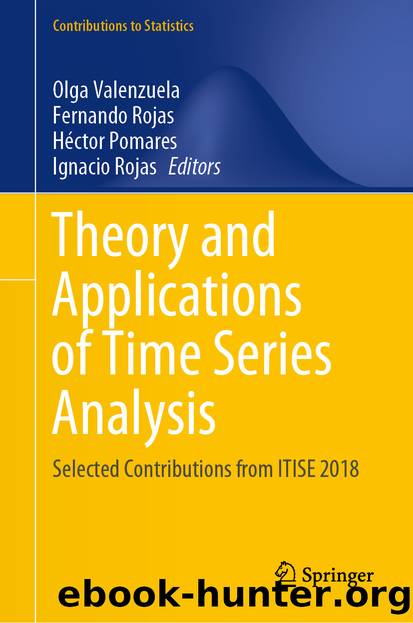Theory and Applications of Time Series Analysis by Unknown

Author:Unknown
Language: eng
Format: epub
ISBN: 9783030260361
Publisher: Springer International Publishing
Forecasting of Multiple Yield Curves via Neural Networks
In order to predict future yields of various maturities and tenors and over different forecasting horizons, we implemented a neural network which we present in the following subsection. Thereafter, we discuss how we dealt with the problem of limited available data, present our forecasting results and elaborate on alternative approaches.
Neural Network Design and Methodology
The neural network is based on the keras package with tensorflow backend. The input layer consists of the mid, bid and ask yields of a specific maturity, the corresponding bid-ask spreads as well as the basis spreads calculated as the difference between the mid values of the risky tenor-dependent yields and the risk-free discount yields for the specified maturity. The output consists of the yields themselves. As we follow a multiple curve approach, this results in a rather large input and output dimension. We use the eminent relationship between the risky and the discount curve in order to fine tune the training process of the neural network. Furthermore, the bid-ask spread is included in order to teach the network about market depth.
We ran a hyperparameter optimization code using the R package flags which searches for the best hyperparameter combination on a discrete grit. Afterwards, we also implemented the whole code in Python and used the hyperparameter optimization procedure based on the hyperas package, which is more advanced. For a deeper insight on grid searches versus random searches, we refer to [3]. The network architecture based on the hyperparameter optimization consists of three layers and two dropout layers in between. The first layer is an LSTM layer with 128 neurons. The next layers are given by a second LSTM layer with 32 neurons and a third dense layer. The drop out rates are set to 0.195327 and 0.056875 while the learning rate is chosen as and is allowed to decay over time.
We chose 3 neurons in the output layer since we analyse only one maturity at a time for three different curves (discount, three-month and six-month curve) and the last layer is supposed to directly correspond to the number of outputs. For a deeper insight on Long-Short-Term-Memory neural networks, we refer the reader to [13] and emphasize the ability to store and forget important, respectively redundant, information of those layers.
The LSTM layer in keras needs a 3-dimensional input shape. It is, therefore, necessary to reshape the given dataset in tensor form. The first dimension corresponds to the number of historical dates used as a training, respectively test, data set. The last dimension agrees with the number of input, respectively output parameters. In our case, this amounts to 14 parameters—one fixed maturity times three curves and three different values (mid, ask, bid) already yields 9 dimensions. When adding three bid-ask spreads and 2 basis spreads, one ends up with 14 input parameters. The second dimension specifies how much data is used to be fitted to one output unit. Here, we chose chunks of 300 data points meaning that the last 300 values are used to find a connection to the next value of interest.
Download
This site does not store any files on its server. We only index and link to content provided by other sites. Please contact the content providers to delete copyright contents if any and email us, we'll remove relevant links or contents immediately.
International Integration of the Brazilian Economy by Elias C. Grivoyannis(86464)
The Radium Girls by Kate Moore(11866)
Turbulence by E. J. Noyes(7894)
Nudge - Improving Decisions about Health, Wealth, and Happiness by Thaler Sunstein(7458)
The Black Swan by Nassim Nicholas Taleb(6946)
Rich Dad Poor Dad by Robert T. Kiyosaki(6316)
Pioneering Portfolio Management by David F. Swensen(6168)
Man-made Catastrophes and Risk Information Concealment by Dmitry Chernov & Didier Sornette(5877)
Zero to One by Peter Thiel(5637)
Secrecy World by Jake Bernstein(4593)
Millionaire: The Philanderer, Gambler, and Duelist Who Invented Modern Finance by Janet Gleeson(4299)
Skin in the Game by Nassim Nicholas Taleb(4122)
The Age of Surveillance Capitalism by Shoshana Zuboff(4117)
The Money Culture by Michael Lewis(4025)
Bullshit Jobs by David Graeber(3991)
Skin in the Game: Hidden Asymmetries in Daily Life by Nassim Nicholas Taleb(3867)
The Dhandho Investor by Mohnish Pabrai(3635)
The Wisdom of Finance by Mihir Desai(3605)
Blockchain Basics by Daniel Drescher(3429)
